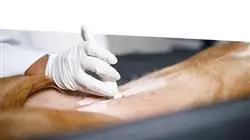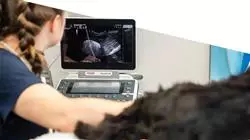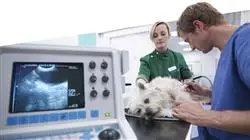University certificate
The world's largest faculty of veterinary medicine”
Why study at TECH?
A complete Hybrid professional master’s degree that perfectly combines the most up-to-date theoretical knowledge with the practical application of the most up-to-date techniques and procedures during a stay in a first class veterinary clinic"

The applications of ultrasound in veterinary medicine are very broad and cover studies of almost all parts of the animal patient. Pet clinics and hospitals around the world have been incorporating these technologies into their care units because they facilitate imaging of soft tissue and affected bones. In this way, little by little, the services have been enriched. On the other hand, innovations have allowed all technologies to adjust to mobility, creating smaller equipment that is used by mobile companies. In view of the growing need for specialization in this area, TECH has created an innovative program composed of two distinct educational periods.
In the first stage, the Identify the advantages of ultrasound scanning over other diagnostic imaging tests in small mammals, birds and reptiles.. Likewise, you will master the physical principles that occur in an ultrasound scanner, as well as its basic operation in order to understand what is visualized in an ultrasound image and how to obtain it. At the same time, it will examine the correct exploration technique of each specific organ, based on an acute assimilation of the positioning of the viscera included in this module.
This Hybrid professional master’s degree treats Ultrasound as a separate entity within clinical practice with the aim of obtaining highly qualified professionals, addressing, among many other aspects, the most advanced applications of the technique such as the performance of ultrasound-guided punctures and biopsies. All these skills will be complemented by a 3-week practical internship in a specialized first level health care center.
A high-intensity Hybrid professional master’s degree that will allow you to specialize in the use of veterinary ultrasound, with the expertise of a high-level experienced professional”
This Hybrid professional master’s degree in Small Animal Ultrasound contains the most complete and up-to-date scientific program on the market. The most important features include:
- Development of more than 100 clinical cases presented by veterinary surgeons and university professors with extensive experience in minimally invasive techniques
- Its graphic, schematic and practical contents provide scientific and assistance information on those medical disciplines that are essential for professional practice
- Veterinary patient assessment and monitoring, the latest international recommendations in minimally invasive surgery
- Comprehensive surgical approach plans for small animals
- Presentation of practical workshops on diagnostic, and therapeutic techniques for the veterinary patient
- An algorithm-based interactive learning system for decision-making in the clinical situations presented throughout the course
- Practical clinical guides on approaching different pathologies
- With a special emphasis on evidence-based medicine and the most effective methodologies in Surgery Small Animal Veterinary Surgery
- All of this will be complemented by theoretical lessons, questions to the expert, debate forums on controversial topics, and individual reflection assignments
- Content that is available from any fixed or portable device with an Internet connection
- Furthermore, you will be able to carry out a clinical internship in one of the best veterinary centers in the world
Acquire the most up-to-date knowledge in the handling and interpretation of ultrasound tests in the veterinary clinic and make a leap in your competitiveness in the sector"
In this proposal for a Hybrid professional master’s degree, of a professionalizing nature and hybrid learning modality, the program is aimed at updating veterinary professionals who perform their functions in surgical units, and who require a high level of qualification. The contents are based on the latest scientific evidence, and oriented in a didactic way to integrate theoretical knowledge in veterinary practice, and the theoretical-practical elements will facilitate the updating of knowledge and allow decision making in the management of small animals.
Thanks to its multimedia content developed with the latest educational technology, they will allow the veterinary professional a situated and contextual learning, that is to say, a simulated environment that will provide an immersive learning programmed to train in real situations. This program is designed around Problem-Based Learning, whereby the professional must try to solve the different professional practice situations that arise throughout the program. This will be done with the help of an innovative interactive video system created by renowned veterinary experts.
With the support of the best valued methodology of online teaching, this Hybrid professional master’s degree will allow you to learn in a comfortable way and with great impact for your professional practice"

With this blended Master you will master the techniques of veterinary ultrasound to be able to diagnose different conditions in the soft tissues of animals through images"
Teaching Planning
The contents of this program have been developed by the different experts of this Hybrid professional master’s degree with the objective that the student acquires each and every one of the necessary skills to become true experts in veterinary ultrasound. Its structure and internship plan make this degree the most complete on the market today, as it covers all the relevant knowledge for the veterinarian to develop successfully. It has ten modules that allow a study classified by different knowledge related to animal cardiopathy, cardiovascular exploration, or a complete study of the functioning of the electrocardiogram.or the complete study of the functioning of the electrocardiogram.

You will master diagnosis with the most accurate and up-to-date ultrasound systems of the moment, thanks to the quality content of this TECH program"
Module 1. Ultrasound Diagnosis
1.1. The ultrasound scanner
1.1.1. Frequency (F)
1.1.2. Depth
1.1.3. Acoustic Impedance
1.1.4. Physical Phenomena
1.1.4.1. Reflection
1.1.4.2. Refraction:
1.1.4.3. Absorption
1.1.4.4. Dispersion
1.1.4.5. Attenuation
1.1.5. Transduction and Transducer
1.2. Operation of an ultrasound scanner
1.2.1. Patient Selection and Data Entry
1.2.2. Types of Exam (Preset)
1.2.3. Transducer Position
1.2.4. Freeze, Save, or Pause Image
1.2.5. Cineloop
1.2.6. Image Mode Selection
1.2.7. Depth
1.2.8. Zoom
1.2.9. Focus
1.2.10. Gain
1.2.11. Frequency (F)
1.2.12. Sector Size
1.3. Types of Probe
1.3.1. Sectorial
1.3.2. Lineal
1.3.3. Microconvex
1.4. Ultrasound Modes
1.4.1. M-Mode
1.4.2. Two-dimensional Mode
1.4.3. Transesophageal Echocardiogram
1.5. Doppler Ultrasound
1.5.1. Physical Principles
1.5.2. Indications
1.5.3. Types
1.5.3.1. Spectral Doppler
1.5.3.2. Pulsed Doppler
1.5.3.3. Continuous Doppler
1.6. Harmonic and Contrast Ultrasound
1.6.1. Harmonic Ultrasound
1.6.2. Contrast Ultrasound
1.6.3. Utilities
1.7. Patient Preparation
1.7.1. Prior Preparation
1.7.2. Positioning
1.7.3. Sedation?
1.8. Ultrasounds on the Patient
1.8.1. How Do Ultrasound Waves Behave When Passing Through Tissue?
1.8.2. What Can We See in the Image?
1.8.3. Echogenicity
1.9. Image Orientation and Expression
1.9.1. Orientation
1.9.2. Terminology
1.9.3. Examples:
1.10. Artefacts
1.10.1. Reverberation
1.10.2. Acoustic Shadow
1.10.3. Lateral Shadow
1.10.4. Posterior Acoustic Enhancement
1.10.5. Margin Effect
1.10.6. Mirror or Specular Image
1.10.7. Scintillation Artefact
1.10.8. Aliasing
Module 2. Abdominal Ultrasound Scan I
2.1. Scanning Technique
2.1.1. Introduction
2.1.2. Methodology
2.1.3. Systematization
2.2. Retroperitoneal Cavity
2.2.1. Introduction
2.2.2. Limits
2.2.3. Ultrasound Approach
2.2.4. Pathologies of the Retroperitoneal Cavity
2.3. Urinary Bladder
2.3.1. Introduction
2.3.2. Anatomy
2.3.3. Ultrasound Approach
2.3.4. Urinary Bladder Pathologies
2.4. Kidneys
2.4.1. Introduction
2.4.2. Anatomy
2.4.3. Ultrasound Approach
2.4.4. Kidney Pathology
2.5. Ureters
2.5.1. Introduction
2.5.2. Ultrasound Approach
2.5.3. Ureter Pathology
2.6. Urethra
2.6.1. Introduction
2.6.2. Anatomy
2.6.3. Ultrasound Approach
2.6.4. Urethral Pathologies
2.7. Female Genital System
2.7.1. Introduction
2.7.2. Anatomy
2.7.3. Ultrasound Approach
2.7.4. Pathologies of the Female Reproductive System
2.8. Pregnancy and Post-partum
2.8.1. Introduction
2.8.2. Pregnancy Diagnosis and Estimation of Gestation Time
2.8.3. Pathologies
2.9. Male Genital System
2.9.1. Introduction
2.9.2. Anatomy
2.9.3. Ultrasound Approach
2.9.4. Pathologies of the Female Reproductive System
2.10. Adrenal glands
2.10.1. Introduction
2.10.2. Anatomy
2.10.3. Ultrasound Approach
2.10.4. Pathologies of the Adrenal Gland
Module 3. Abdominal Ultrasound Scan II
3.1. Peritoneal Cavity
3.1.1. Introduction
3.1.2. Methodology
3.1.3. Pathologies of the Peritoneal Cavity
3.2. Stomach
3.2.1. Introduction
3.2.2. Anatomy
3.2.3. Ultrasound Approach
3.2.4. Stomach Pathologies
3.3. Small Intestine
3.3.1. Introduction
3.3.2. Anatomy
3.3.3. Ultrasound Approach
3.3.4. Pathologies of the Small Intestine
3.4. Large Intestine
3.4.1. Introduction
3.4.2. Anatomy
3.4.3. Ultrasound Approach
3.4.4. Pathologies of the Large Intestine
3.5. Bladder
3.5.1. Introduction
3.5.2. Anatomy
3.5.3. Ultrasound Approach
3.5.4. Pathologies of the Spleen
3.6. Liver
3.6.1. Introduction
3.6.2. Anatomy
3.6.3. Ultrasound Approach
3.6.4. Pathologies of the Liver
3.7. Gallbladder
3.7.1. Introduction
3.7.2. Anatomy
3.7.3. Ultrasound Approach
3.7.4. Gallbladder Pathologies
3.8. Pancreas
3.8.1. Introduction
3.8.2. Anatomy
3.8.3. Ultrasound Approach
3.8.4. Pathologies of the Pancreas
3.9. Abdominal Lymph Nodes
3.9.1. Introduction
3.9.2. Anatomy
3.9.3. Ultrasound Approach
3.9.4. Pathologies of the Abdominal Lymph Nodes
3.10. Abdominal Masses
3.10.1. Ultrasound Approach
3.10.2. Localization
3.10.3. Possible Causes/Origins of Abdominal Masses
Module 4. Doppler Ultrasound and its Abdominal Applications
4.1. Doppler Ultrasound
4.1.1. Flow Characteristics
4.1.2. The Doppler Effect
4.2. Types of Doppler
4.2.1. Continuous Wave Doppler
4.2.2. Pulsed Doppler
4.2.3. Duplex Doppler
4.2.4. Color Doppler
4.2.5. Power Doppler (Power Doppler)
4.3. Abdominal Vascular System
4.3.1. Single-vessel Doppler Study
4.3.2. Types of Vascular Flow
4.3.3. Abdominal Vascularization
4.4. Vascular System Applications
4.4.1. Aortic Flow
4.4.2. Vena Cava Flow Rate
4.4.3. Hepatic Vessel Hypertension
4.5. Abdominal Cavity Applications
4.5.1. Renal Vascularization
4.5.2. Vascularization in Abdominal Masses
4.5.3. Vascularization in Parenchymal Organs
4.6. Shunts
4.6.1. Congenital Portosystemic Shunts
4.6.1.1. Intrahepatic
4.6.1.2. Extrahepatic
4.6.2. Acquired Portosystemic Shunts
4.6.3. Arteriovenous Fistulae
4.7. Heart Attacks
4.7.1. Renal
4.7.2. Intestinal
4.7.3. Hepatic
4.7.4. Others
4.8. Thrombosis
4.8.1. Aortic Thromboembolism
4.8.2. Aortic Mineralization
4.8.3. Portal Vein Thrombosis
4.8.4. Vena Cava Thromboembolism
4.9. Lymph Node Vascularization
4.9.1. Exploration
4.9.2. Pathological Abdominal Lymph Nodes
4.10. Intestinal Vovulus
4.10.1. Intestinal Vascularization
Module 5. Other Ultrasound Applications
5.1. Non-cardiac Thoracic Ultrasound
5.1.1. Thoracic Ultrasound Scan
5.1.2. Ultrasound Examination of the Thorax
5.1.3. Findings and Main Pathologies
5.1.4. TFAST
5.2. Cervical Ultrasonography
5.2.1. Cervical Ultrasound Scan
5.2.2. Ultrasound Examination of the Cervical Region
5.2.3. Thyroid and Parathyroid Glands
5.2.4. Lymph Nodes and Salivary Glands
5.2.5. Trachea and Esophagus
5.3. Ophthalmic Ultrasonography
5.3.1. Ophthalmologic Ultrasound Scan
5.3.2. Ultrasound Examination of the Eye and Surrounding Area
5.3.3. Findings and Main Pathologies
5.4. Transcerebral Ultrasound and Gestational Ultrasonography
5.4.1. Ultrasound Scans in Pregnancy
5.4.2. Gestational Screening Protocol
5.4.3. Transcerebral Ultrasound Scan
5.5. Interventional Ultrasonography
5.5.1. Basics of Interventional Ultrasonography
5.5.2. Equipment and Patient Preparation
5.5.3. Types of Punctures and Biopsy
5.5.4. Specific Technique for Each Case?
5.6. Musculoskeletal Ultrasonography
5.6.1. Musculoskeletal Examination
5.6.2. Skeletal Muscle Scanning and Patterning
5.6.3. Musculoskeletal Pathologies
5.7. Ultrasound of Surface Tissues
5.7.1. Basis for Examining Surface Structures
5.7.2. Surface Structure Recognition
5.7.3. Pathologies and Abnormalities in Superficial Tissues
5.8. Echoguided Blocks
5.8.1. Equipment and Basics of Ultrasound-guided Anesthesia
5.8.2. Posterior Third Blocks
5.8.3. Anterior Third Blocks
5.8.4. Other Blocks
5.9. Ultrasonography in Pediatric and Geriatric Animals
5.9.1. Features of Ultrasonography in Pediatrics and Geriatrics
5.9.2. Ultrasound Examination Protocol, Artifacts and Findings
5.9.3. Detectable Pediatric Pathologies and their Ultrasound Patterns
5.10. Emergency Department Ultrasonography
5.10.1. Use of Ultrasound Scans in Emergencies
5.10.2. Emergency Abdominal Ultrasound Scan
5.10.3. Emergency Thoracic Ultrasound Scan
Module 6. Ultrasound in Feline Patients
6.1. Pulmonary Ultrasound Scan
6.1.1. Ultrasound Techniques
6.1.2. Ultrasound Findings in a Healthy Lung
6.1.3. Ultrasound Findings in Pulmonary Conditions
6.1.4. FAST Ultrasound of the Thorax
6.2. Abdominal Ultrasound: Nephrourinary Pathologies
6.2.1. Bladder and Urethra Ultrasound Scans
6.2.2. Kidney and Ureter Ultrasound Scans
6.3. Abdominal Ultrasound: Gastrointestinal Pathologies
6.3.1. Ultrasonography of the Stomach
6.3.2. Ultrasound Scan of the Small Intestine
6.3.3. Ultrasound Scan of the Large Intestine
6.4. Abdominal Ultrasonography: Liver and Biliary Pathologies
6.4.1. Ultrasound Scan of the Liver
6.4.2. Ultrasound Scan of the Biliary Tract
6.5. Abdominal Ultrasonography: Pancreatic and Adrenal Pathologies
6.5.1. Ultrasound Scan of the Pancreas
6.5.2. Ultrasound Scan of the Adrenal Gland
6.6. Abdominal Ultrasound Scan: Splenic and Lymphatic Pathologies
6.6.1. Ultrasound Scan of the Spleen
6.6.2. Ultrasound Scan of the Lymph Nodes
6.7. Ultrasonography of Reproductive Conditions
6.7.1. Gestational Diagnosis
6.7.2. Ultrasound Scan of the Reproductive System in Cats
6.7.3. Ultrasound Scan of the Reproductive System in Cats
6.8. Uses of Doppler Ultrasound in Feline Patients
6.8.1. Technical Considerations
6.8.2. Blood Vessel Abnormalities
6.8.3. Doppler Ultrasound Utilities in Lymph Nodes and Masses
6.9. Ultrasound Scans of Cervical Pathologies
6.9.1. Ultrasound Scans of Glands and Lymph Nodes
6.9.2. Ultrasound Scans of Thyroid and Parathyroid Glands
6.9.3. Ultrasound Scans of the Larynx
6.10. Diagnostic Techniques Applied to Ultrasonography
6.10.1. Ultrasound-guided Punctures
6.10.1.1. Indications
6.10.1.2. Considerations and Specific Equipment
6.10.1.3. Sampling of Intra-abdominal Fluids and/or Cavities
6.10.1.4. Organ and/or Mass Sampling
6.10.2. Use of Contrasts in Feline Ultrasound
6.10.2.1. Types of Contrast in Cats
6.10.2.2. Indications for Using Contrasts
6.10.2.3. Diagnosis of Pathologies by Ultrasound Contrast
Module 7. Ultrasound in Exotic Animals
7.1. Ultrasound Examination of New Companion Animals
7.1.1. Features and handling of New Companion Animals
7.1.2. Patient Preparation
7.1.3. Ultrasound Equipment
7.2. Abdominal Ultrasonography in Rabbits
7.2.1. Ultrasound Scan of the Urinary Tract
7.2.2. Ultrasound Scan of the Reproductive System
7.2.3. Ultrasound Scan of the Digestive System
7.2.4. Ultrasound Scan of the Hepatic and Biliary Tracts
7.2.5. Ultrasound Scan of the Adrenal Glands
7.2.6. Ocular Ultrasonography
7.3. Abdominal Ultrasonography in Rodents
7.3.1. Ultrasonography in Guinea Pigs
7.3.2. Ultrasonography in Chinchillas
7.3.3. Ultrasonography in Small Rodents
7.4. Abdominal Ultrasonography in Ferrets
7.4.1. Ultrasound Scan of the Urinary Tract
7.4.2. Ultrasound Scan of the Reproductive System
7.4.3. Ultrasound Scan of the Digestive System
7.4.4. Ultrasound Scan of the Hepatic and Biliary Tracts
7.4.5. Ultrasound Scan of the Spleen and Pancreas
7.4.6. Ultrasound Scan of the Lymph Nodes and Adrenal Glands
7.5. Ultrasonography in Turtles
7.5.1. Ultrasound Scan of the Urinary Tract
7.5.2. Ultrasound Scan of the Reproductive System
7.5.3. Ultrasound Scan of the Digestive System
7.5.4. Hepatic Ultrasound Scan
7.6. Ultrasonography in Lizards
7.6.1. Diagnostic and Physiological Ultrasonography
7.6.2. Renal Ultrasound Scan
7.6.3. Ultrasound Scan of the Reproductive System
7.6.4. Hepatic Ultrasound Scan
7.7. Ultrasonography in Snakes
7.7.1. Diagnostic and Physiological Ultrasonography
7.7.2. Renal Ultrasound Scan
7.7.3. Ultrasound Scan of the Reproductive System
7.7.4. Ultrasound Scan of the Digestive System
7.7.5. Hepatic Ultrasound Scan
7.8. Ultrasonography in Birds
7.8.1. Diagnostic and Physiological Ultrasonography
7.8.2. Ultrasound Scan of the Reproductive System
7.8.3. Hepatic Ultrasound Scan
7.8.4. Echocardiography in Birds
7.9. Thoracic Ultrasound Scan
7.9.1. Thoracic Ultrasonography in Rabbits
7.9.2. Thoracic Ultrasonography in Guinea Pigs
7.9.3. Thoracic Ultrasonography in Ferrets
7.10. Echocardiography
7.10.1. Echocardiography in Rabbits
7.10.2. Echocardiography in Ferrets
Module 8. Echocardiography I. Echocardiographic Examination. Examination Methods Application to Cardiology
8.1. Echocardiography
8.1.1. Equipment and Probes
8.1.2. Patient Positioning
8.1.3. Echocardiographic Examination Methods
8.2. Keys to Carrying Out an Optimal Echocardiographic Study
8.2.1. How to Optimize the Performance of my Ultrasound Equipment
8.2.2. Factors affecting the quality of an Echocardiographic Study
8.2.3. Artifacts in Echocardiography
8.3. Echocardiographic Slicing
8.3.1. Right Side Parasternal Cuts
8.3.2. Left Side Parasternal Cuts
8.3.3. Subcostal Cuts
8.4. M Mode Echocardiographic Examination
8.4.1. How to Optimize the Image in M Mode
8.4.2. M Mode Applied to the Left Ventricle
8.4.3. M Mode Applied Mitral Valve
8.4.4. M Mode Applied Aortic Valve
8.5. Color and Spectral Doppler Echocardiographic Examinations
8.5.1. Physical Principles of Color Dopplers
8.5.2. Physical Principles of Spectral Dopplers
8.5.3. Color Doppler Imaging
8.5.4. Pulsed Doppler Imaging Importance of Continuous Dopplers in Echocardiography
8.5.5. Tissue Doppler
8.6. Echocardiographic Examination of the Aortic and Pulmonary Valves
8.6.1. Color Doppler Mode at Aortic Valve
8.6.2. Color Doppler Mode at Lung Valve
8.6.3. Spectral Doppler Mode at Aortic Valve
8.6.4. Spectral Doppler Mode at Lung Valve
8.7. Echocardiographic Examination of Mitral/Tricuspid Valves and Pulmonary Veins
8.7.1. Color Doppler Mode at Mitral and Tricuspid Valves
8.7.2. Spectral Doppler Mode at Mitral and Tricuspid Valves
8.7.3. Spectral Doppler Mode at Pulmonary Veins
8.8. Assessment of Systolic and Diastolic Function Using Echocardiography
8.8.1. Determination of Systolic Function in 2D Mode
8.8.2. Determination of Systolic Function in M Mode
8.8.3. Determination of Systolic Function in Spectral Doppler Mode
8.9. Assessment of Systolic and Diastolic Function Using Echocardiography
8.9.1. Determination of diastolic Function in 2D Mode
8.9.2. Determination of Diastolic Function in M Mode
8.9.3. Determination of Diastolic Function in Spectral Doppler Mode
8.10. Echocardiographic Examination to Assess Hemodynamics Application in Cardiology
8.10.1. Pressure Gradients
8.10.2. Systolic Pressure
8.10.2. Diastolic Pressure
Module 9. Echocardiography II Assessment of Main Cardiac Diseases
9.1. Valvular Diseases
9.1.1. Chronic Mitral Valve Degeneration
9.1.2. Chronic Tricuspid Valve Degeneration
9.1.3. Atrioventricular valve stenosis
9.1.4. Semilunar Valve Abnormalities
9.2. Pulmonary Hypertension
9.2.1. Echocardiographic Signs of Pulmonary Hypertension: B Mode
9.2.2. Echocardiographic Signs of Pulmonary Hypertension: M Mode
9.2.3. Echocardiographic Signs of Pulmonary Hypertension: Doppler
9.2.4. Causes and Differentiation of Types of Pulmonary Hypertension
9.3. Myocardial Diseases
9.3.1. Canine Dilated Cardiomyopathy
9.3.2. Arrhythmogenic Right Ventricular Cardiomyopathy
9.3.3. Myocarditis
9.4. Feline Cardiomyopathies
9.4.1. Hypertrophic Cardiomyopathy
9.4.2. Restrictive Cardiomyopathy
9.4.3. Feline Dilated Cardiomyopathy
9.4.4. Arrhythmogenic Cardiomyopathy
9.4.5. Unclassified Cardiomyopathies
9.5. Pericardium and Pericardiocentesis
9.5.1. Idiopathic Pericarditis
9.5.2. Constrictive Pricarditis
9.5.3. Other Pericardial Diseases
9.5.4. Pericardiocentesis
9.5.5. Pericardiectomy
9.6. Cardiac Neoplasms
9.6.1. Hemangiosarcoma
9.6.2. Cardiac-based Tumors
9.6.3. Lymphoma
9.6.4. Mesothelioma
9.6.5. Others
9.7. Congenital Heart Diseases I
9.7.1. Patent Ductus Arteriosus
9.7.2. Pulmonary Stenosis
9.7.3. Subaortic Stenosis
9.7.4. Interventricular and Interatrial Defects
9.7.5. Valvular Dysplasia
9.8. Congenital Heart Diseases II
9.8.1. Interventricular and Interatrial Defects
9.8.2. Valvular Dysplasia
9.8.3. Tetralogy of Fallot
9.8.4. Others
9.9. Dirofilariasis and Other Cardiopulmonary Worms
9.9.1. Canine and Feline Dirofilariasis
9.9.2. Canine Angiostrongylosis
9.9.3. Complementary Tests
9.10. Transesophageal Echocardiography and 3D Echocardiography
9.10.1. Transesophageal Echocardiogram: Basics
9.10.2. Transesophageal Echocardiogram: Indications
9.10.3. 3D Echocardiogram: Basics
9.10.4. 3D Echocardiogram: Indications
Module 10. Preparing an Ultrasound Report
10.1. Ultrasound Jargon I
10.1.1. Nomenclature, Description and the Diagnostic Uses of Different Artifacts
10.1.2. Relative Echogenicity
10.1.3. Comparative Echogenicity
10.2. Ultrasound Jargon II
10.2.1. Structural Description of Selected Organs
10.2.2. Using the Movement of Structures and Organs for Assessing the Latter
10.2.3. Location of Each Organ in Space and Its Relation to Anatomical Landmarks
10.3. Registering a Study
10.3.1. How Should an Image Study be Recorded and Stored
10.3.2. Study Validity Period
10.3.3. Which Images and How Should I Attach Them to the Report?
10.4. Report Templates
10.4.1. What is the Purpose of an Ultrasound Report
10.4.2. Basic Outline of a Professional Ultrasound Report
10.4.3. Specific Outline of Selected Ultrasound Reports
10.5. Indices
10.5.1. Distances
10.5.2. Volumes
10.5.3. Ratios or Indices
10.5.4. Speeds
10.6. Description of Lesions Observed
10.6.1. Mnemonic Rule FOR TA CON E ES U V
10.6.2. Subjective Assessments
10.6.3. Objective Assessments
10.7. Diagnoses
10.7.1. Differential Diagnoses
10.7.2. Presumptive Diagnosis
10.7.3. Firm Diagnosis
10.8. Final Recommendations
10.8.1. Limitations of Ultrasound Studies (Operator-Dependent Technique)
10.8.2. Diagnostic Recommendations
10.8.3. Therapeutic Guidelines
10.9. Echocardiographic Report
10.9.1. Function
10.9.2. Structure of the Echocardiographic Report
10.9.3. Differences Between Abdominal Ultrasound Reports of Other Organs and Cardiac Ultrasound Reports
10.10. Using Templates
10.10.1. Using Templates Preparation of Own Reports
10.10.2. Ultrasound Report Templates
10.10.3. How Can I Stand Out From the Rest by Creating My Own Templates?

A learning process so complete and exciting that it will become a unique occasion of professional and personal Difficulties"
Hybrid Professional Master's Degree in Small Animal Ultrasound
Ultrasound is a non-invasive diagnostic imaging technique that uses high-frequency sound waves to create detailed images of the internal organs of animals. It is a very useful tool for detecting diseases in early stages and planning more effective treatment. Thinking of expanding the knowledge of professionals interested in working in this sector, TECH Global University developed a very complete Hybrid Professional Master's Degree in Small Animal Ultrasound that, in addition to addressing in its syllabus the most up-to-date contents, includes a unique methodology in the market. In this program, designed by specialists in the sector, you will learn the interpretation of images and the use of ultrasound equipment. You will also learn to recognize pathologies in different organs such as the heart, liver, spleen and kidney. This will allow you to identify and treat diseases in animals with greater precision.
Become a small animal ultrasound expert
Ultrasound is a non-invasive and very useful tool for identifying health problems in animals. By using high-frequency sound waves to create detailed images of internal organs, veterinarians can detect diseases in early stages and plan more effective treatment. With this comprehensive TECH program, you will gain the knowledge you need to be proficient in the field. In addition to the theoretical classes, you will also have the opportunity to put your knowledge into practice in laboratory and practical sessions in veterinary hospitals. These experiences will allow you to work with real animals and perfect your skills in performing ultrasounds. In this way, you will improve the care you provide to your patients, increasing your competitiveness in the labor market by offering highly valued specialized services.







